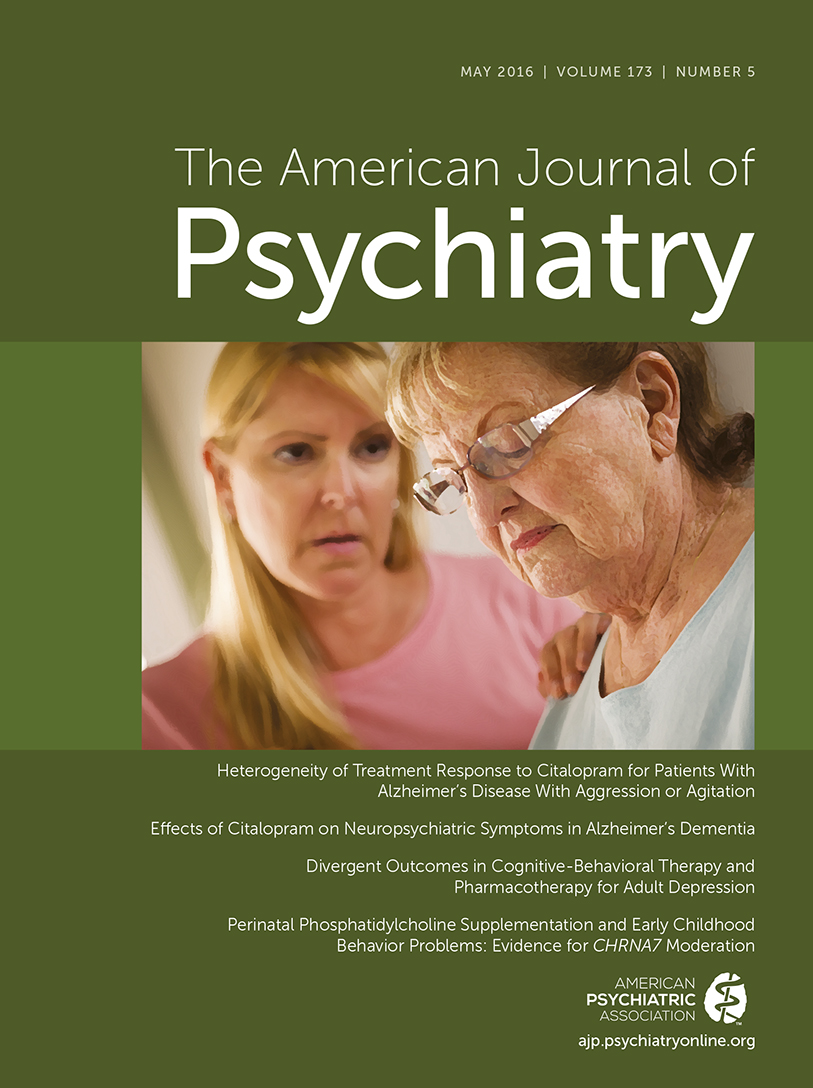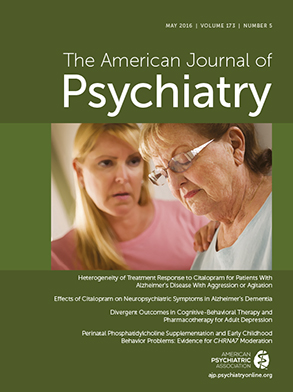Disturbances in inhibitory function are thought to play a central role in schizophrenia. Cognitive deficits, a core feature strongly related to disability in the illness, have been attributed to dysfunction of specific classes of GABA-ergic interneurons (
1), disrupting neural synchrony that is critical for cognition. Investigations of GABA in vivo in schizophrenia, especially in unmedicated patients, are relatively recent and correspondingly few, in part because of technical challenges in the available neurochemical imaging modalities, positron emission tomography (PET) and magnetic resonance spectroscopy (MRS).
The report by Marenco and colleagues in this issue (
2) helps inform the field by presenting a comprehensive study of GABA in psychosis in the dorsal anterior cingulate cortex. The authors addressed three main questions: Are GABA levels abnormal in this region in medicated patients with psychosis? How does medication status affect the findings? Do unaffected siblings of patients provide an intermediate GABA phenotype?
Marenco et al. investigated the first question with the largest cohort yet—70 medicated patients with psychosis and 184 control subjects. They found a decrease in the GABA/creatine ratio but not in the GABA/water ratio, an alternative method of referencing the GABA signal. On balance, these data indicate a modest decrease in GABA in the medicated patients.
In a smaller sample of 25 patients, the authors controlled for medication status by acquiring a scan when the patients were on medication and another when they had been off medication (for a mean of 3.7 months; SD=5 months; minimum=14 days). These data showed no GABA abnormality in the unmedicated state and no change in GABA levels between the two scans. As an alternative approach, the authors asked how GABA levels and medication dosage were related within the large group of medicated patients. They found an inverse relationship, consistent with a chlorpromazine-equivalent dose-dependent GABA-lowering effect of antipsychotic medication.
An investigation of 31 proband–unaffected sibling pairs sought to determine whether these siblings might represent an intermediate GABA phenotype. The data showed significantly lower GABA levels in the unaffected siblings and a modest but significant degree of familiality, although as the authors noted, the interpretation as an intermediate phenotype is limited by the absence of a substantial decrease in GABA in the patients themselves.
In short, the study is important for its main findings: a modest decrease in GABA in the dorsal anterior cingulate cortex in the largest cohort of medicated patients yet studied; an absence of GABA abnormality in this brain region in unmedicated patients, together with an absence of a longitudinal effect of antipsychotic medication in the same patients; and significantly lower GABA levels in unaffected siblings of psychotic patients. The study’s strengths are the large size of the medicated patient sample and the novelty of examining GABA levels in this brain region in patients on and then off medication as well as in unaffected siblings.
A technical strength of the report is the presentation of both the creatine and water normalizations of the GABA measurements. Each of these reference denominators has been widely used and each has its advantages and disadvantages, but a particular caveat for the creatine denominator is its own potential alteration with illness (
3). A trend-level increase in creatine/water ratio in the medicated patient group does appear to have contributed to the smaller GABA/creatine ratio, ultimately weakening the conclusion of a significant decrease in GABA/creatine in the medicated group. Also in the medicated group, conclusions regarding antipsychotic medication effects are limited by the potential effects on GABA from the additional medications taken by 80% of this group. In the chlorpromazine-equivalent analysis of medication dosage effects, other treatment variables, such as additional (potentially GABA-modulating) drugs, and intermediating variables, such as severity of illness, may have affected the GABA-dosage relationship. The smaller, controlled on-off medication study appears to give the more definitive information: an absence of GABA abnormality in the unmedicated state, and absence of effect of antipsychotic medication. An alternative interpretation of the sibling comparison, that lower GABA is protective or serves as a resilience factor and helps prevent psychosis in the unaffected siblings, is limited by the absence of elevation in GABA in the patients in this brain region, just as the intermediate phenotype interpretation is limited by the absence of a significant GABA deficit.
How do the findings of this study compare with previous data and contribute to the emerging picture of GABA dysfunction in psychosis?
In comparison with the MRS literature, this report fits well, strengthening earlier results and adding new information. In the medicated patients, the modest GABA decrease is consistent with previous data on schizophrenia in this brain region (
4). The longitudinal on-off medication finding is consistent with a controlled matched-cohort cross-sectional study in another dorsal region, the dorsolateral prefrontal cortex, which showed no abnormality off medication and no effect of antipsychotic medication (
5). The novel genetic finding will be more readily interpreted—whether low GABA is a resilience factor or an intermediate phenotype—as a fuller regional mapping of GABA function in psychosis is developed.
This larger anatomic context, the regional variability of MRS GABA measurements, presents the greatest challenge in an endeavor to reconcile the postmortem, PET, and MRS literature. Postmortem studies have reported abnormalities in GABA transmission-related proteins and mRNA that are similar across multiple brain regions and point to widespread transmission deficits at fast-spiking parvalbumin-positive interneurons (
1,
6). Similarly, a PET study of pharmacologically stimulated GABA release found global deficits across multiple brain regions, although present only in medication-naive patients (
7). In contrast, the four MRS studies thus far of unmedicated patients or at-risk individuals have shown marked regional variability. GABA levels have been found to be elevated in the striatum (
8) and the medial pregenual prefrontal cortex (
5,
8), unchanged in the dorsal anterior cingulate cortex (
2) and the dorsolateral prefrontal cortex (
5), and decreased in the visual cortex (
9).
In attempting to understand this regional variability, it is helpful to note an important difference between the nature of the outcome measures in MRS and those in postmortem and PET studies: MRS aggregates GABA levels in tissue across all compartments, whereas postmortem and PET measurements relate to synaptic transmission. From this standpoint, reconciliation of the findings raises the question of how tissue levels can show so much regional variability in the face of a relatively regionally stable synaptic deficit. We can speculate that the variable pattern detected by MRS reflects disturbed glutamatergic projections onto the observed target regions, resulting in aberrant stimulation of unimpaired local GABA-ergic neurons—those not in the fast-spiking, parvalbumin-positive categories. Support for this possibility comes from observations of consistent glutamatergic alterations in schizophrenia in several brain regions, particularly in unmedicated patients (
4,
5,
10). Under this scenario, MRS adds important circuitry information not readily available when looking at local synaptic function of the fast-spiking interneurons, and can be viewed as probing variable disturbances in glutamatergic projections. This viewpoint suggests that dorsal regions (
2,
5) may play a smaller role in the functional disturbances of schizophrenia than more ventral regions with large GABA elevations found by MRS (
5,
8). Further studies along the lines of the Marenco et al. study are needed, region by region, to test these ideas and help complete the map of abnormal glutamatergic projections and their effects on local glutamate and GABA levels in psychosis.

